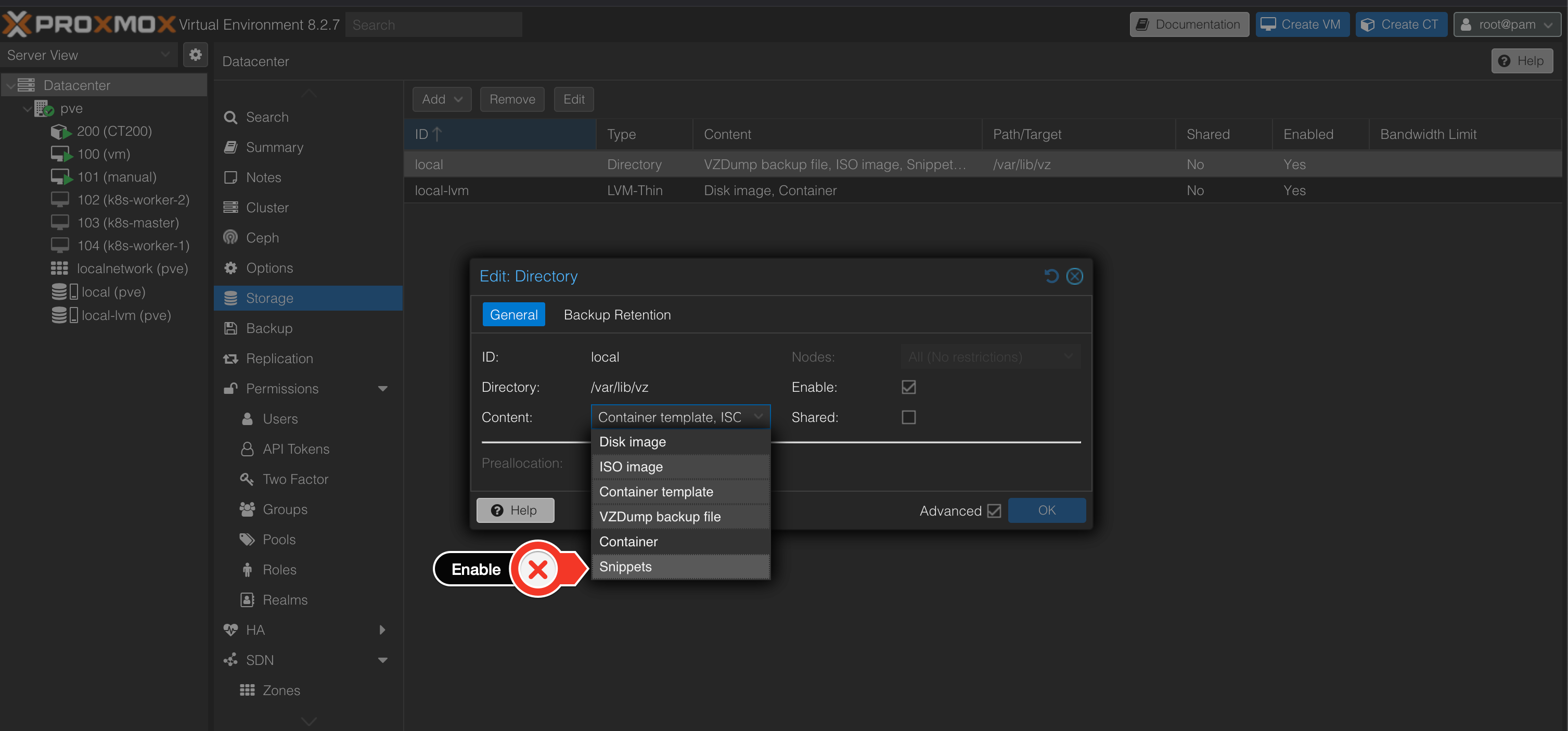Setting up Kubernetes on Proxmox with Cloud-Init and Pulumi— Part I
Provisioning the compute resource for k8s

In this blog post, we’ll explore how to set up a Kubernetes cluster on Proxmox using cloud-init for VM initialization during their first boot and Pulumi for infrastructure as code.
Prerequisite

Ensure snippets are enabled in Storage Configuration:
-
Go to Datacenter > Storage in the Proxmox GUI.
-
Edit an existing storage (or add a new one) that supports snippets
-
Ensure the
Contentfield includes the Snippets type, as showed in the above screenshot.
Cloud-Init Configuration
Let’s break down the cloud-init configuration used to set up k8s nodes.
User Setup
users:
- name: ubuntu
sudo: ALL=(ALL) NOPASSWD:ALL
lock_passwd: false
passwd: $6$SP/vqykLkV9d05An$mJ/fEZ3gmfVvD1vwSJqxfjsK9z/bykIMbCZ/Hov.nt31e8h0XklDSE7ofw2YjPemVOSm14JdYoEfEzbxkFkY/1
ssh_authorized_keys:
- ssh-ed25519 AAAAC3NzaC1lZDI1NTE5AAAAIHDtJdQ12Q8pUUGM16V1Ko+es5LzuGT/0FGWWTmsKQxj
This section creates a user named “ubuntu” with sudo privileges and adds SSH access.
System Configuration
write_files:
- path: /etc/modules-load.d/k8s.conf
permissions: '0644'
content: |
overlay
br_netfilter
- path: /etc/sysctl.d/k8s.conf
permissions: '0644'
content: |
net.bridge.bridge-nf-call-iptables = 1
net.bridge.bridge-nf-call-ip6tables = 1
net.ipv4.ip_forward = 1
These configurations includes necessary kernel modules and system parameters for Kubernetes
Network Configuration
- path: /etc/netplan/00-installer-config.yaml
permissions: '0600'
content: |
network:
version: 2
ethernets:
ens18:
dhcp4: true
dhcp6: false
optional: true
nameservers:
addresses: [8.8.8.8, 8.8.4.4]
This sets up the network interface using Netplan, configuring DHCP and DNS
Installation and Configuration Commands
runcmd:
# Set hostname
- hostnamectl set-hostname ${hostname}
# Basic system setup
- modprobe overlay
- modprobe br_netfilter
- sysctl --system
- systemctl restart systemd-timesyncd
# Network configuration
- netplan generate
- netplan apply
# Wait for network connectivity
- |
count=0
max_attempts=30
until ping -c 1 8.8.8.8 >/dev/null 2>&1 || [ $count -eq $max_attempts ]; do
echo "Waiting for network connectivity... Attempt $count of $max_attempts"
sleep 5
count=$((count + 1))
done
# Update and install basic packages
- apt-get update
- apt-get install -y apt-transport-https ca-certificates curl software-properties-common
# Setup Kubernetes repository
- mkdir -p /etc/apt/keyrings
- curl -fsSL https://pkgs.k8s.io/core:/stable:/v1.29/deb/Release.key | gpg --dearmor -o /etc/apt/keyrings/kubernetes-archive-keyring.gpg
- echo 'deb [signed-by=/etc/apt/keyrings/kubernetes-archive-keyring.gpg] https://pkgs.k8s.io/core:/stable:/v1.29/deb/ /' > /etc/apt/sources.list.d/kubernetes.list
# Install packages
- apt-get update
- |
DEBIAN_FRONTEND=noninteractive apt-get install -y \
wget \
vim \
net-tools \
qemu-guest-agent \
kubelet \
kubeadm \
kubectl \
containerd
# Hold kubernetes packages
- apt-mark hold kubelet kubeadm
# Install Nix package manager
- curl --proto '=https' --tlsv1.2 -sSf -L https://install.determinate.systems/nix | sh -s -- install --no-confirm
# Enable and start services
- systemctl enable qemu-guest-agent
- systemctl start qemu-guest-agent
- systemctl enable kubelet
- systemctl start kubelet
# Set bash as the default shell
- chsh -s /bin/bash ubuntu
The runcmd section includes a series of commands to set the hostname, Load kernel modules, Apply system configurations, Set up networking, Install necessary packages including Kubernetes components and containerd, Install the Nix package manager and Enable and start required services.
Pulumi Code for Kubernetes Setup
Now, let’s look at how we can use Pulumi with Go to set up our infra setup for k8s cluster on Proxmox.
Cloud-init setup
Below function reads & customizes the cloud-init configuration and uploads the yml file into Proxmox.
func createCloudInit(ctx *pulumi.Context, provider *proxmoxve.Provider, nodeName string, hostname string) (*storage.File, error) {
configPath := filepath.Join("cloud-init", "cloud-init.yml")
data, err := os.ReadFile(configPath)
if err != nil {
return nil, err
}
content := string(data)
replacements := map[string]string{
"${hostname}": hostname,
}
for k, v := range replacements {
content = strings.ReplaceAll(content, k, v)
}
return storage.NewFile(ctx, hostname+"-cloud-init", &storage.FileArgs{
NodeName: pulumi.String(nodeName),
DatastoreId: pulumi.String("local"),
ContentType: pulumi.String("snippets"),
FileMode: pulumi.String("0755"),
Overwrite: pulumi.Bool(true),
SourceRaw: storage.FileSourceRawArgs{
Data: pulumi.String(content),
FileName: pulumi.String(hostname + ".yml"),
},
}, pulumi.Provider(provider))
}
Provisioning VM
Below core function handles the creation of a VM.
func createVM(ctx *pulumi.Context, provider *proxmoxve.Provider, config NodeConfig, cloudInit *storage.File, cloudImage *download.File, bridge string) (*vm.VirtualMachine, error) {
return vm.NewVirtualMachine(ctx, config.Name, &vm.VirtualMachineArgs{
NodeName: pulumi.String("pve"),
Name: pulumi.String(config.Name),
Agent: vm.VirtualMachineAgentArgs{Enabled: pulumi.Bool(true)},
Cpu: &vm.VirtualMachineCpuArgs{Cores: pulumi.Int(config.Cores)},
Memory: &vm.VirtualMachineMemoryArgs{
Dedicated: pulumi.Int(config.Memory),
Floating: pulumi.Int(config.Memory),
},
Disks: &vm.VirtualMachineDiskArray{
vm.VirtualMachineDiskArgs{
Size: pulumi.Int(config.DiskSize),
Interface: pulumi.String("scsi0"),
Iothread: pulumi.Bool(true),
FileFormat: pulumi.String("raw"),
FileId: cloudImage.ID(),
},
},
BootOrders: pulumi.StringArray{pulumi.String("scsi0"), pulumi.String("net0")},
ScsiHardware: pulumi.String("virtio-scsi-single"),
OperatingSystem: vm.VirtualMachineOperatingSystemArgs{
Type: pulumi.String("l26"),
},
NetworkDevices: vm.VirtualMachineNetworkDeviceArray{
vm.VirtualMachineNetworkDeviceArgs{
Model: pulumi.String("virtio"),
Bridge: pulumi.String(bridge),
},
},
OnBoot: pulumi.Bool(true),
Initialization: &vm.VirtualMachineInitializationArgs{
DatastoreId: pulumi.String("local-lvm"),
UserDataFileId: cloudInit.ID(),
},
}, pulumi.DependsOn([]pulumi.Resource{cloudImage}), pulumi.Provider(provider))
}
Originally published on Medium
🌟 🌟 🌟 The source code for this blog post can be found here 🌟🌟🌟
Reference: